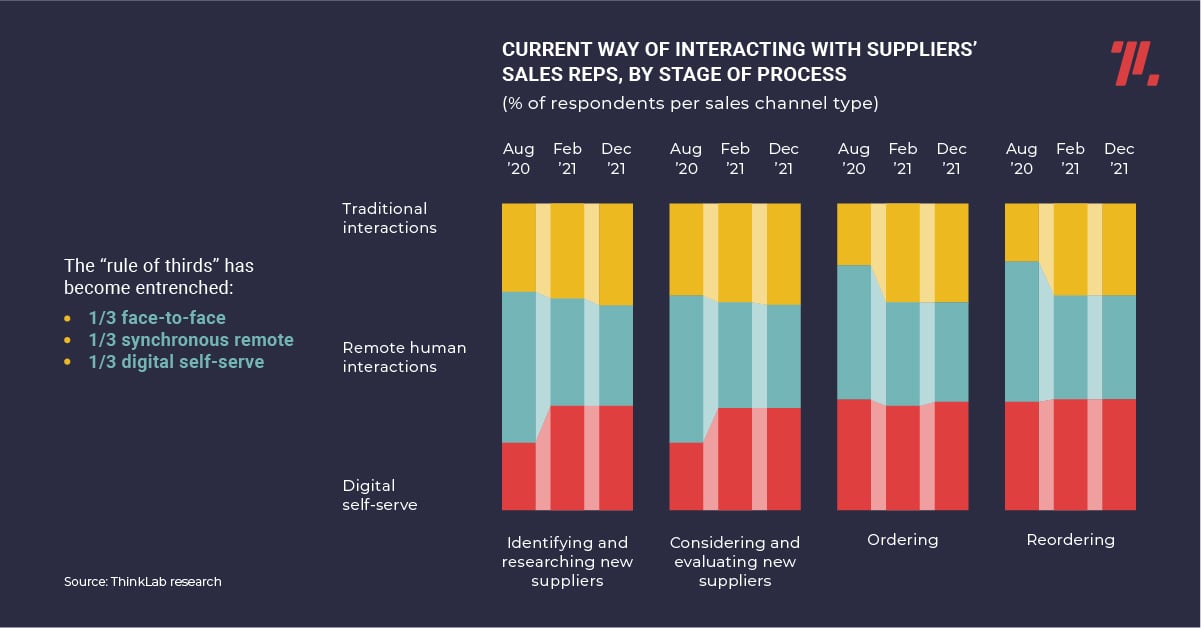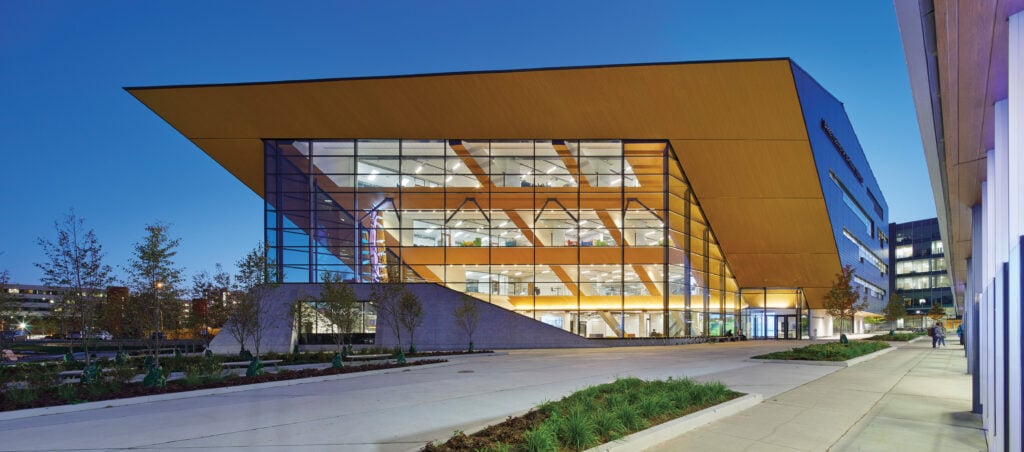February 17, 2023
5 Shifts to Make in 2023 to Future-Proof Your Business
ThinkLab kicks off each new year by looking at the 10 biggest shifts affecting the future of the contract interiors industry. Whether you are a design firm, manufacturer, or distributor, this annual exploration summarizes where we’re headed, and how we can prepare our organizations to stay competitive.
Here, we share the five shifts you should already be focused on to ensure your business doesn’t fall behind. In part two, we’ll cover five shifts you can focus on to get (or stay) ahead.
1. A Shift from Communication to Connection

Ironically, the interiors industry is struggling with the very challenges we are advising our clients on today. We are in our own awkward adolescence, undergoing a crucial transition. This means reframing our own workflows from in-person connection, mentorship by observation, and analog ways of doing business into connected cultures, with workflows optimized for true connection across multiple fronts (in-office, hybrid, and remote). As with the rest of the world, ThinkLab industry-specific data shows that individual workers still prefer for hybrid work, while companies have a prefer more time spent in the office.
Here’s the bottom line:
Communication is something that’s done transactionally, while connection is felt. Connecting takes a lot more intentionality if it’s done digitally. We need to be careful that we don’t choose convenience over connection.
One action you can take today
Learn how others within the design ecosystem are navigating their client’s new normal in this podcast.
2. A Shift from Talent Acquisition to Talent Transformation

Our industry is finding new ways to retain existing talent, embracing DE&I initiatives to attract new talent, and rebuilding teams post “the Great Resignation”—especially as the skill sets needed for success in some sectors of our industry are evolving. From 2019–2021, the top 100 Interior Design Giants of Design reduced their staff by 48 percent, and now they are trying to rebuild in one of the most competitive job markets we’ve ever seen.
As the industry evolves, many manufacturers and distributors are in need of new types of industry talent, and the onboarding process is often long and unsuccessful. Recruiting the right people and retaining our star players has arguably never been more important.
Here’s the bottom line:
The 2020–2021 period has been called the Great Reevaluation. If you’re not helping your best asset—your people—up their game, you’re missing the boat (or missing people in your boat).
One action you can take today:
Check out the industry’s first-ever CEU podcast, especially our episode on how to design for equity and belonging. Or, if you’re not a designer, check out ThinkLab courses designed for the product side of our industry.
3. A Shift from “Just Sustainability” to Social Consciousness

As Metropolis reported in 2020, the interior design industry will have influence over one-tenth of the world’s carbon emissions by 2050. Further, the average designer has 26 times the specification power as the average American consumer has buying power—and that number can be as much as 111 times more when you get into the Interior Design Giants of Design. Simply put, our decisions matter. And research shows Gen Z is influencing all generations to make sustainability-first decisions, even if cost is not equal.
But today, “sustainability” goes beyond just recycled or recyclable product. According to recent NielsenIQ insights, the socially conscious shoppers of 2022 want to “choose products and support brands that are good for them, good for their neighbors, and good for the planet.” This social activism must be true to the brand—not a marketing ploy.
Here’s the bottom line:
The sustainability conversation today is much broader than before. Today, your brand is either authentically practicing what it preaches, or it’s seen as detracting from the cause.
One action you can take today:
Check out this podcast that explores how our industry can make better decisions when it comes to the environment.
4. A Shift from Chaos to Controlled

What does ThinkLab hear as the top issue on business leaders’ minds today? Supply chain woes. This notable Business of Homes podcast episode shares how that is becoming a fading concern in 2023, at least on the residential side. However, as of the end of 2022, ThinkLab research shows that it is still topping the list for commercial clients, designers, and distributors.

Here’s the bottom line:
Residual supply-chain challenges are pushing leading organizations to shift their perspective to what’s in their control. From adopting new technologies to localizing their supply chains, tomorrow’s leaders are leaving less to chance and are managing their clients’ expectations with more transparency than ever.
One action you can take today:
Check out this Mpowered podcast episode, where ThinkLab answers a listener-submitted question about how to explain to their clients why these issues are still happening.
5. A Shift from “Selling To” to “Buying With”

According to broad McKinsey research, more than 90 percent of B2B companies feel their current sales model is more effective than it was pre-pandemic. In contrast, a ThinkLab survey of in-industry leaders found that only 56 percent of companies surveyed feel their model today is more successful. This means that most companies (and reps) are still struggling to navigate changes accelerated by the past couple of years.
McKinsey research suggests that these changes are here to stay and recommend companies follow a best practice called “the rule of thirds.” This means the ideal client journey is now:
- 1/3 face-to-face
- 1/3 digital and synchronous (Zoom, phone, etc.)
- 1/3 asynchronous self-serve
Ironically, ThinkLab data suggests that, in our industry, the average rep has gone from spending 80 percent of their time face-to-face before the pandemic to less than half of their time today. This puts ThinkLab in-industry data squarely in line with McKinsey data. We’ve found that roughly 30 percent to 35 percent (or one-third) of the average rep’s time is now face-to-face.
The bottom line:
If you haven’t mastered the basics in this increasingly phygital (physical + digital) world, you’re already playing from behind. Leading brands are proactively piloting technologies to simplify the buyer’s journey and leading with empathy to help their human capital evolve for a new era.
One action you can take today:
Check out this podcast, where we interview one of the researchers behind that great McKinsey research and translate it to what this means for our beloved industry.
Next week, in part two, we’ll explore five shifts you want to tackle to get ahead.

Amanda Schneider is president of ThinkLab, the research division of SANDOW. Join in to explore what’s next at thinklab.design/join-in.
Would you like to comment on this article? Send your thoughts to: [email protected]
Latest
Products
Autodesk’s Forma Gets You Ahead of the Curve on Carbon
Autodesk Forma leverages machine learning for early-phase embodied carbon analysis.
Products
Eight Building Products to Help You Push the Envelope
These solutions for walls, openings, and cladding are each best-in-class in some way—offering environmental benefits, aesthetic choices, and design possibilities like never before.
Viewpoints
3 Sustainability News Updates for Q3 2024
Policy initiatives are gathering momentum as the federal government and building sector organizations align their expertise under the umbrella of the Inflation Reduction Act.





